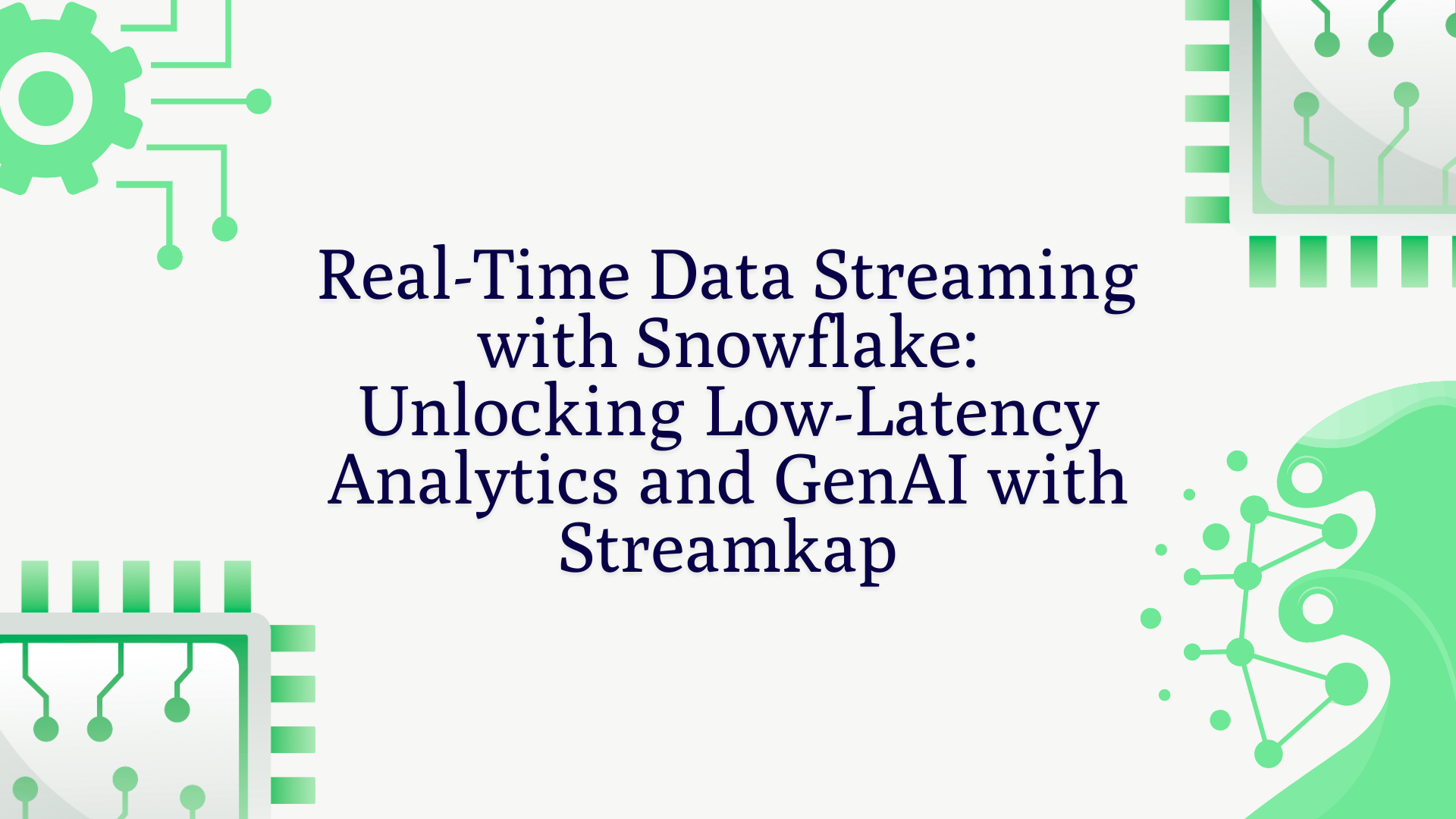Real-Time Data Streaming with Snowflake: Unlocking Low-Latency Analytics and GenAI with Streamkap
Real-time data streaming has become a game-changer for modern data pipelines, and Snowflake's advancements in Snowpipe Streaming and Dynamic Tables are at the forefront of this transformation. As co-founder and CTO of Streamkap, I presented at the Snowflake London Meetup on May 13, 2025, diving into how real-time streaming with Snowflake simplifies architectures, slashes costs, and powers use cases from operational analytics to Generative AI (GenAI). This blog expands on that presentation, exploring why real-time streaming with Snowflake is more accessible than ever, key streaming patterns, and how Streamkap bridges the gap for seamless, low-latency data ingestion. This post provides actionable insights for data engineers, business leaders, and AI practitioners looking to leverage Snowflake for real-time data pipelines.
We'll cover Snowflake's evolution, cost-saving architectures like Kappa, practical streaming patterns, and real-world examples that demonstrate up to 75% cost reductions and sub-second latency. Let's dive into how Snowflake and Streamkap are redefining real-time data processing.
Why Real-Time Streaming with Snowflake Now?
Historically, data teams shied away from real-time streaming due to perceived complexity and cost, favoring batch ETL with the mindset of "we don’t need real-time." In 2025, this perspective is outdated. Snowflake’s advancements, combined with tools like Apache Kafka, Debezium, and Streamkap, have made streaming faster, cheaper, and simpler than traditional batch processing. Fewer software components and less orchestration mean data teams can deliver real-time insights without breaking the bank.
Snowflake’s Real-Time Evolution
Snowflake has transformed streaming capabilities:
- 2017: Snowpipe Introduction: Enabled basic streaming but was limited by file-based storage and 1-minute latency.
- 2022-2025: Snowpipe Streaming: Direct streaming with 1-second latency, 10x cheaper than batch methods.
- Dynamic Tables: Near-real-time materialization with 1-minute latency (15s in preview), streamlining transformations.
Why It Matters
- Cost Efficiency: Snowpipe Streaming reduces compute costs significantly (e.g., SpotOn cut costs by 75%).
- Simplified Pipelines: Tools like Streamkap and Kafka reduce setup complexity.
- GenAI Demand: LLMs and AI agents require fresh data to avoid degraded outputs, making real-time pipelines critical for personalization and analytics.
- Market Shift: Competitors are adopting real-time for dashboards, alerting, and AI—lagging behind risks obsolescence.
Real-time streaming with Snowflake is now the optimal choice for nearly all use cases, from low-latency dashboards to AI-driven personalization.
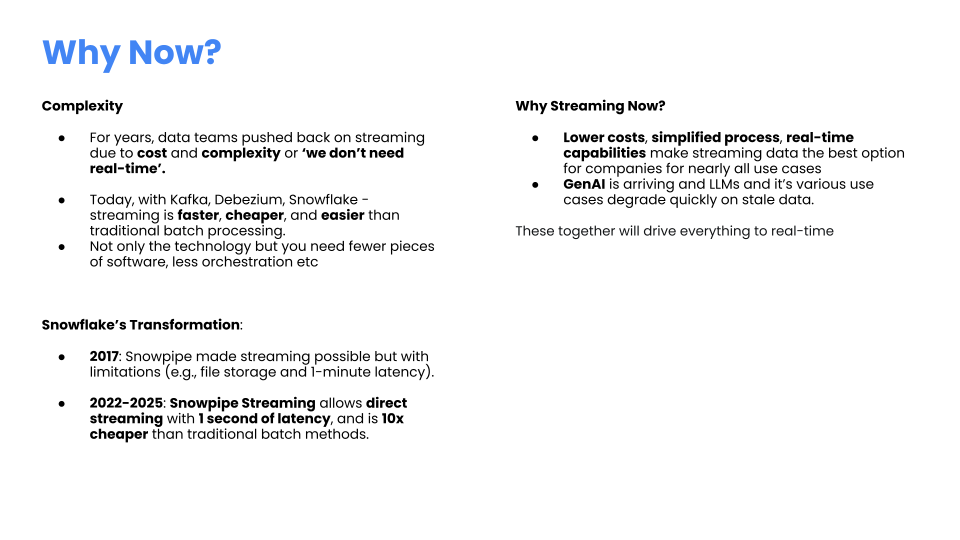
Evolving to a Streaming-First Architecture with Snowflake
Traditional data architectures like Lambda are giving way to streamlined, real-time approaches that integrate seamlessly with Snowflake.
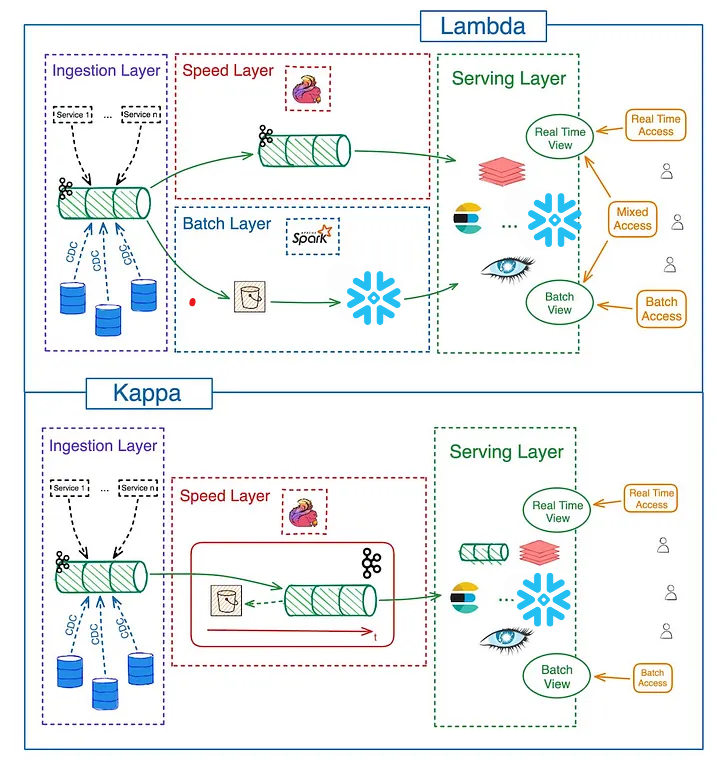
*Based on the original image from the source.
Limitations of the Lambda Architecture
The Lambda architecture splits data into batch and speed layers:
- Batch Layer: Processes historical data, often slow and resource-heavy.
- Speed Layer: Handles real-time but requires separate pipelines, leading to complexity.
- Drawbacks: High costs (e.g., repeated ETL in Snowflake), data inconsistencies, and reverse ETL for insights.
This multi-hop approach is costly and inefficient, especially for real-time GenAI or analytics.
The Kappa Architecture: Unified Streaming with Snowflake
Kappa treats all data as a continuous stream, leveraging Snowflake’s Snowpipe Streaming:
- Core Benefits: Replayable Kafka logs, unified pipelines, and direct ingestion to Snowflake.
- Implementation: Streamkap syncs historical and real-time data via Debezium, pushing to Kafka and Snowflake with minimal latency.
- Progress: API limitations are fading as direct-to-Kafka and direct-to-Snowflake integrations grow.
Shift-Left for Efficiency
Moving transformations before Snowflake (shift-left) enhances efficiency:
- How It Works: Transform data in real-time using Python or JavaScript before ingestion.
- Benefits: Consistent data, reduced Snowflake compute costs, lower latency, and faster time-to-market.
- Example: Streamkap enables shift-left transforms, cutting costs and enabling multiple data products.
Kappa with Snowflake delivers 4x faster pipelines at 3x lower costs, as seen in real-world deployments.
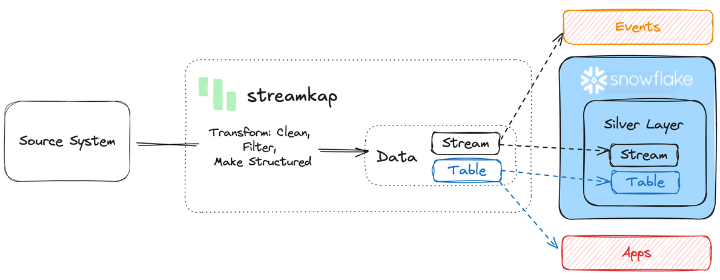
Key Real-Time Streaming Patterns with Snowflake
Snowflake’s Snowpipe Streaming and Dynamic Tables enable powerful streaming patterns for diverse use cases. Here’s how they work:
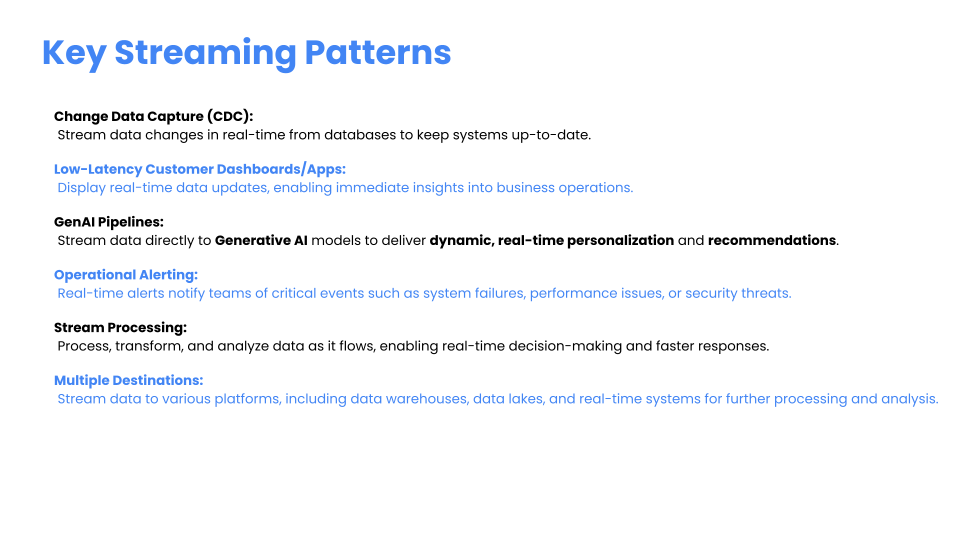
Change Data Capture (CDC)
- Overview: Captures real-time database changes and streams them to Snowflake.
- Examples:
- Walmart: Streams sales and inventory to Snowflake for live dashboards.
- Uber: Real-time ride updates for operational analytics in Snowflake.
- Snowflake Integration: Snowpipe Streaming ingests CDC data with 1-second latency.
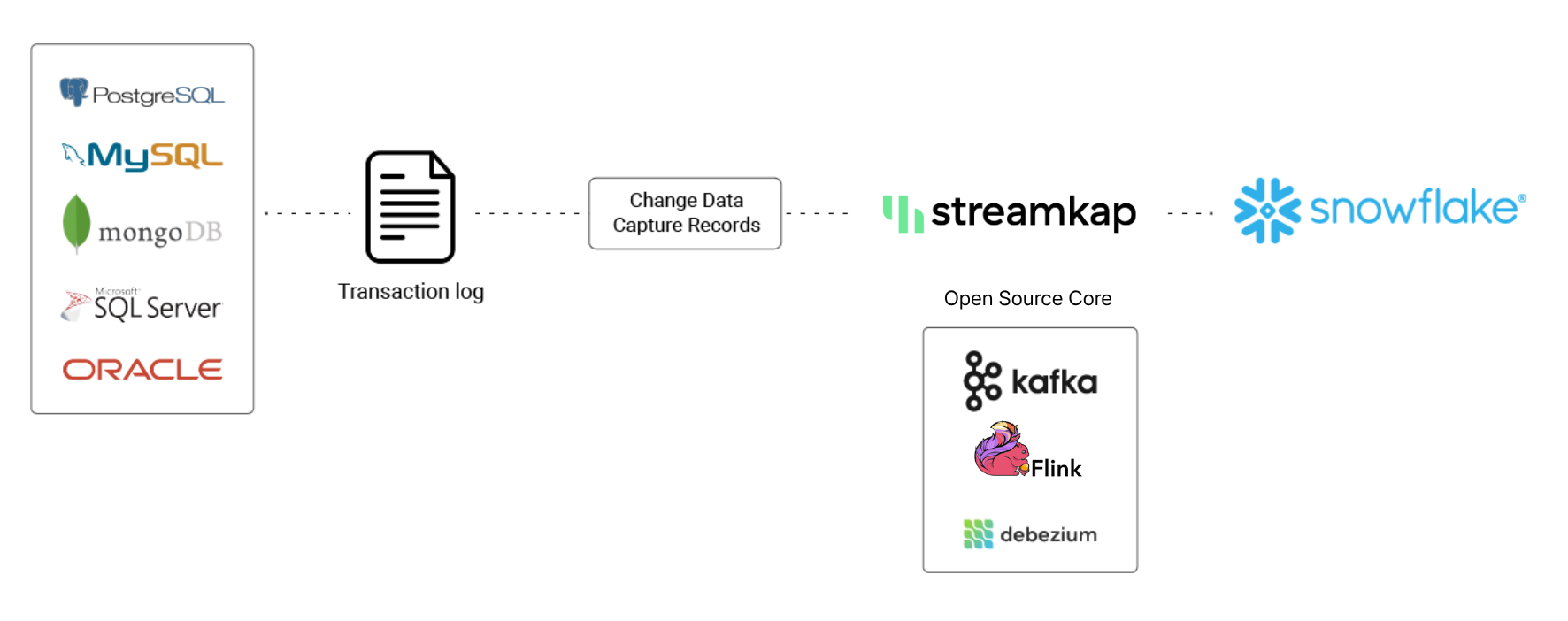
Low-Latency Dashboards and Apps
- Overview: Powers real-time internal or customer-facing dashboards.
- Example: SpotOn uses Streamkap to stream POS data to Snowflake, enabling instant payroll calculations.
- Snowflake Benefit: Dynamic Tables materialize data for dashboards with 1-minute latency.
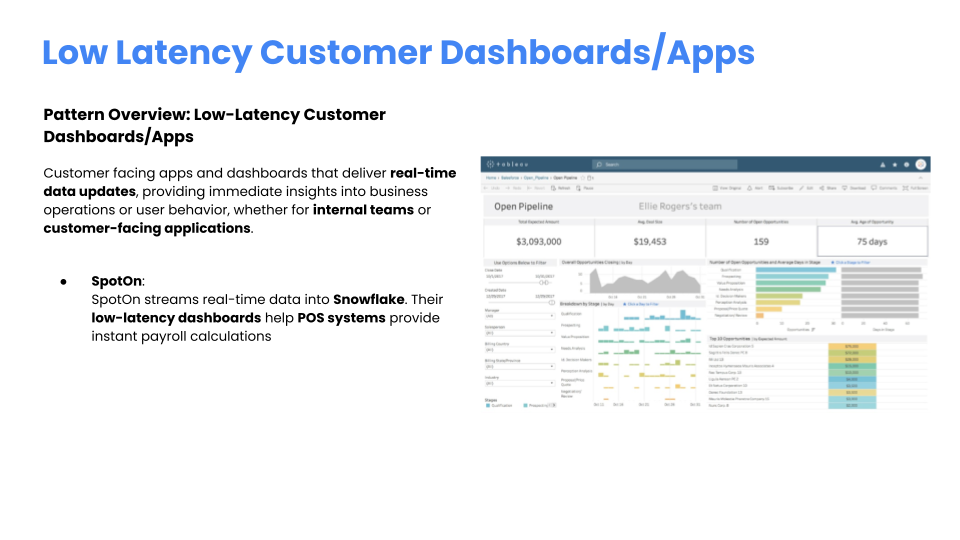
GenAI Pipelines
- Overview: Streams fresh data to GenAI models for dynamic outputs.
- Examples:
- Netflix: Streams viewing history to Snowflake for real-time recommendation updates.
- Ada.cx: Integrates multi-source data into Snowflake for context-aware AI responses.
- Snowflake Role: Snowpipe Streaming ensures sub-second data freshness for AI.
Operational Alerting
- Overview: Real-time alerts for system failures or performance issues.
- Examples:
- Shipmonk: Streams inventory data to Snowflake for logistics management.
- Fleetio: Real-time fleet data for reporting via Streamkap and Snowflake.
- Snowflake Advantage: Reliable, scalable ingestion for alerting pipelines.
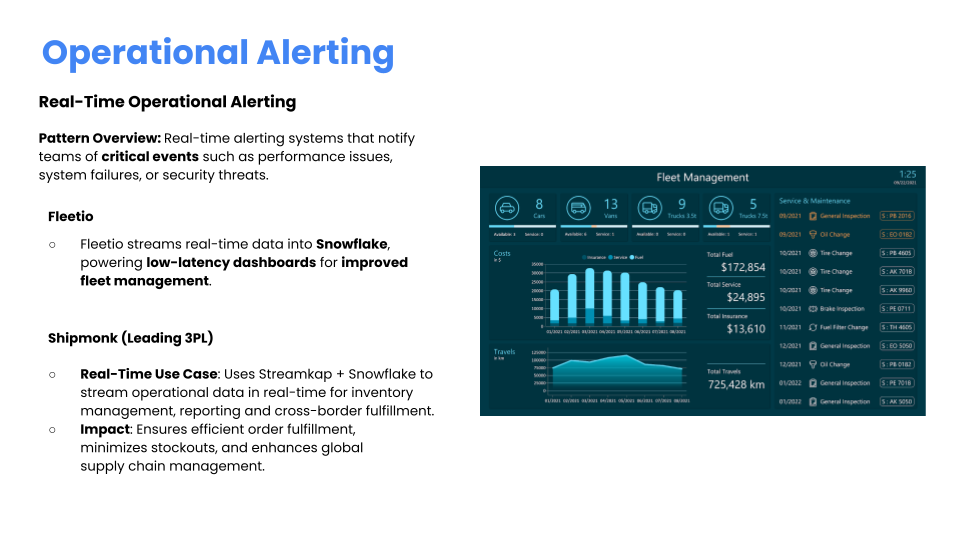
Stream Processing
- Overview: Transforms and analyzes data in real-time before or within Snowflake.
- Sub-Patterns:
- Transform/Filter: Use Python for complex logic before Snowflake ingestion.
- JOINs: Combine streams (e.g., user activity + product data) in real-time.
- Enrichment: Cache lookups for performance.
- Un-Nesting: Flatten JSON for Snowflake compatibility.
- Fan Out/Fan In: Consolidate multiple sources into Snowflake tables.
- Example: Limble CMMS merges 220k tables into Snowflake sub-second.


Multiple Destinations
- Overview: Streams to Snowflake, S3, or Iceberg for analytics, archival, or data lakes.
- Example: Brandalley streams to Snowflake for recommendations, adding £10m in revenue.
These patterns, powered by Snowflake, enable robust real-time pipelines.

Snowflake’s Snowpipe Streaming and Dynamic Tables in Action
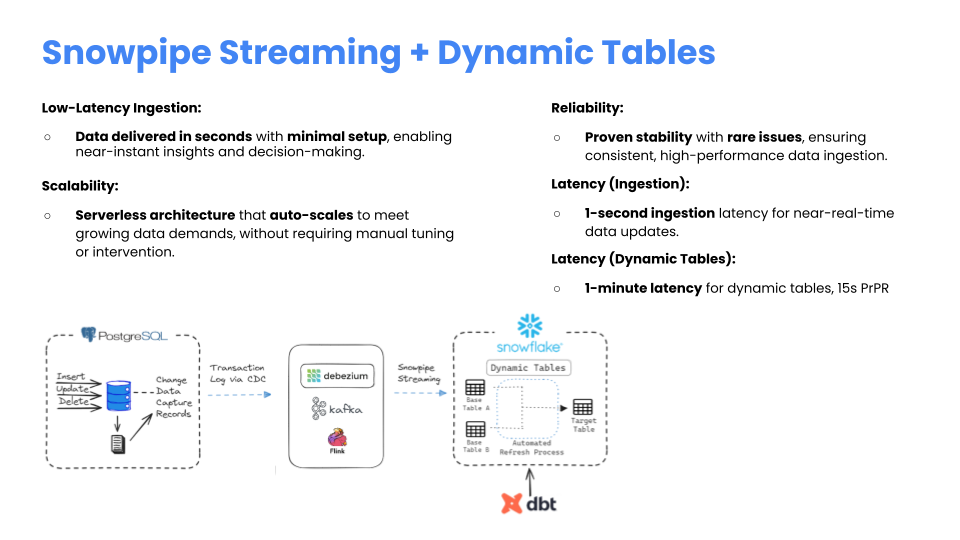
Snowflake’s tools are purpose-built for real-time:
- Snowpipe Streaming: 1-second ingestion latency, serverless scalability, and proven reliability.
- Dynamic Tables: 1-minute latency (15s in preview) for near-real-time materialization.
- Cost Savings: Reduces warehouse compute by streamlining transformations.
Case Study: SpotOn
- Before: Batch ETL cost 390 credits/week ($3,354/month), 20-minute latency.
- After: Streamkap + Snowpipe Streaming reduced costs to 132 credits/week ($1,135/month), 5-minute latency—75% savings, 4x faster.
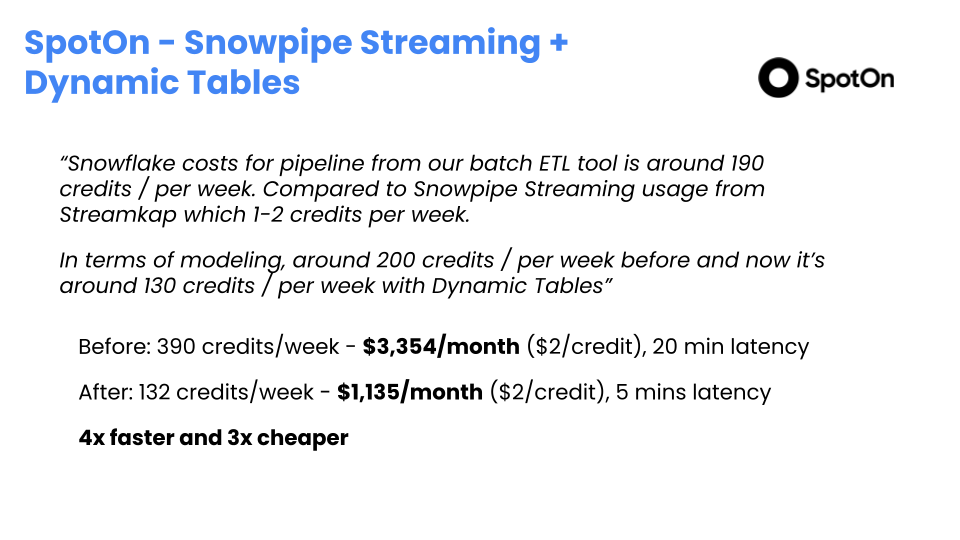
Demo: Real-Time Ingestion with Streamkap and Snowflake
In the meetup, I showcased Streamkap streaming data from database logs via Kafka to Snowflake using Snowpipe Streaming. The demo highlighted shift-left transformations (e.g., Python-based filtering), sub-second latency, and multi-destination support, proving streaming’s simplicity over batch ETL.

Why Adopt Real-Time Streaming with Snowflake Now?
- Snowflake’s Edge: Near-real-time ingestion at lower costs.
- GenAI Necessity: Live data powers AI agents and personalization.
- Market Pressure: Competitors like SpotOn and Fleetio are already leveraging Snowflake for real-time.
- Streamkap’s Role: Bridges streaming ingestion, making it as easy as Fivetran but with real-time capabilities.
Streamkap enables:
- Seamless Integration: Streams from Debezium to Snowflake, supporting Kappa architecture.
- Cost-Effectiveness: Flexible frequency for tailored use cases.
- Future-Proofing: Prepares for streaming transformations and Iceberg adoption.
As streaming becomes as affordable as batch, Snowflake users can build faster, better experiences, just like Uber disrupted taxis.
Conclusion
Real-time streaming with Snowflake’s Snowpipe Streaming and Dynamic Tables, paired with Streamkap, unlocks low-latency analytics and GenAI at scale. From Brandalley’s £10m revenue boost to SpotOn’s 75% cost savings, the ROI is clear.
Get started with a free trial now.

